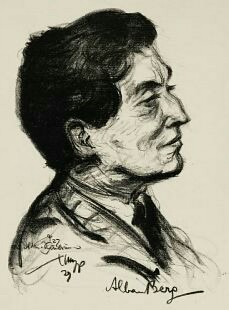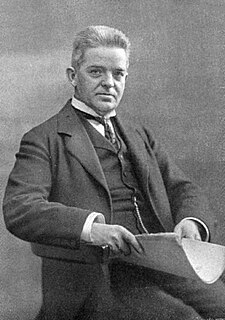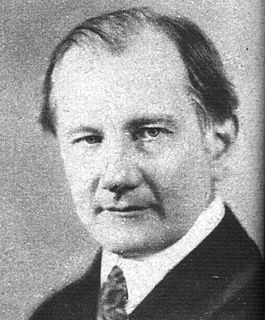Related Research Articles
Robert Wilfred Levick Simpson was an English composer and long-serving BBC producer and broadcaster.

Alban Berg's Violin Concerto was written in 1935. It is probably Berg's best-known and most frequently performed instrumental piece, in which the composer sought to reconcile diatonicism and dodecaphony. Berg composed it on a commission from Louis Krasner, and it became the last work that he completed. Krasner performed the solo part in the premiere at the Palau de la Música Catalana, Barcelona on 19 April 1936, after the composer's death.

Music for Strings, Percussion and Celesta, Sz. 106, BB 114 is one of the best-known compositions by the Hungarian composer Béla Bartók. Commissioned by Paul Sacher to celebrate the tenth anniversary of the chamber orchestra Basler Kammerorchester, the score is dated September 7, 1936.

The Symphony No. 1 in F minor by Dmitri Shostakovich was written in 1924–1925, and first performed in Leningrad by the Leningrad Philharmonic under Nikolai Malko on 12 May 1926. Shostakovich wrote the work as his graduation piece at the Petrograd Conservatory, completing it at the age of 19.
Concerto in F is a composition by George Gershwin for solo piano and orchestra which is closer in form to a traditional concerto than his earlier jazz-influenced Rhapsody in Blue. It was written in 1925 on a commission from the conductor and director Walter Damrosch. It is just over half an hour long.

Petrushka is a ballet and orchestral concert work by Russian composer Igor Stravinsky. It was written for the 1911 Paris season of Sergei Diaghilev's Ballets Russes company; the original choreography was by Michel Fokine and stage designs and costumes by Alexandre Benois, who assisted Stravinsky with the libretto. The ballet premiered at the Théâtre du Châtelet on 13 June 1911 with Vaslav Nijinsky as Petrushka, Tamara Karsavina as the lead ballerina, Alexander Orlov as the Moor, and Enrico Cecchetti the charlatan.

The Symphony No. 6 in A major, WAB 106, by Austrian composer Anton Bruckner (1824–1896) is a work in four movements composed between September 24, 1879 and September 3, 1881 and dedicated to his landlord, Anton van Ölzelt-Newin. Though it possesses many characteristic features of a Bruckner symphony, it differs the most from the rest of his symphonic repertory. Redlich went so far as to cite the lack of hallmarks of Bruckner's symphonic compositional style in the Sixth Symphony for the somewhat bewildered reaction of supporters and critics alike.

Symphony No. 5, Op. 50, FS 97 is a symphony composed by Carl Nielsen in Denmark between 1920 and 1922. It was first performed in Copenhagen on 24 January 1922 with the composer conducting. It is one of two of Nielsen's six symphonies lacking a subtitle, the other being the first.
Symphony No. 4, Op. 29, FS 76, also known as "The Inextinguishable", was completed by Danish composer Carl Nielsen in 1916. Composed against the backdrop of the First World War, this symphony is among the most dramatic that Nielsen wrote, featuring a "battle" between two sets of timpani.
A Symphony to Dante's Divine Comedy, S.109, or simply the "Dante Symphony", is a choral symphony composed by Franz Liszt. Written in the high romantic style, it is based on Dante Alighieri's journey through Hell and Purgatory, as depicted in The Divine Comedy. It was premiered in Dresden in November 1857, with Liszt conducting himself, and was unofficially dedicated to the composer's friend and future son-in-law Richard Wagner. The entire symphony takes approximately 50 minutes to perform.

Ein Heldenleben, Op. 40, is a tone poem by Richard Strauss. The work was completed in 1898. It was his eighth work in the genre, and exceeded any of its predecessors in its orchestral demands. Generally agreed to be autobiographical in nature despite contradictory statements on the matter by the composer, the work contains more than thirty quotations from Strauss's earlier works, including Also sprach Zarathustra, Till Eulenspiegel, Don Quixote, Don Juan, and Death and Transfiguration.

The Symphony No. 3 in C major, Op. 52, by Jean Sibelius is a symphony in three movements composed in 1907. Coming between the romantic intensity of Sibelius's first two symphonies and the more austere complexity of his later symphonies, it is a good-natured, triumphal, and deceptively simple-sounding piece. The symphony's first performance was given by the Helsinki Philharmonic Society, conducted by the composer, on 25 September 1907. In the same concert, his suite from the incidental music to Belshazzar's Feast, Op. 51, was also performed for the first time. It is dedicated to the British composer Granville Bantock an early champion of his work in the UK.
The Symphony No. 3 by Robert Simpson was written in 1962 and dedicated to veteran composer Havergal Brian. The premiere was given by the City of Birmingham Symphony Orchestra on 14 March 1963 under the conductor Hugo Rignold. Its BBC Proms premiere was given by the Royal Philharmonic Orchestra on 21 August 1967 under the conductor Charles Groves. The US premiere was given by the Oklahoma City Symphony Orchestra on 8 December 1974 under its then Music Director, Ainslee Cox.
The Symphony No. 5 by Robert Simpson was written in 1972 and "dedicated in admiration" to the London Symphony Orchestra, who gave the premiere on May 3, 1973, conducted by Andrew Davis. The second performance in England didn't take place until 1984.
Robert Simpson composed his Seventh Symphony in 1977, the same year he completed his Sixth Symphony. The work is dedicated to Hans Keller and his wife, Milein Keller, and was first performed by the Royal Liverpool Philharmonic Orchestra, conducted by Brian Wright at the Philharmonic Hall, Liverpool on 30 October 1984. It is a one-movement work of approximately 28 minutes duration, and since its first performance it has become one of Simpson’s most frequently heard symphonies.
The Symphony No. 8 by Robert Simpson was completed in 1981 and commissioned by the Royal Philharmonic Society. The first performance was given at the Royal Festival Hall on 10 November 1982 by the Royal Danish Orchestra conducted by Jerzy Semkow. The work employs a large orchestra which includes two sets of timpani and four horns. It one of Simpson’s largest, richest and most complex scores.
Robert Simpson composed his Symphony No. 10 in 1988 and dedicated it to the conductor Vernon Handley who gave the premiere of the work in the Philharmonic Hall, Liverpool, on 16 January 1991 with the Royal Liverpool Philharmonic Orchestra. This is Simpson's largest and longest symphony, being one of his most contrapuntal works and in four substantial movements.
Pyotr Ilyich Tchaikovsky composed his Orchestral Suite No. 3 in G, Op. 55 in 1884, writing it concurrently with his Concert Fantasia in G, Op. 56, for piano and orchestra. The originally intended opening movement of the suite, Contrastes, instead became the closing movement of the fantasia. Both works were also intended initially as more mainstream compositions than they became; the fantasia was intended as a piano concerto, while the suite was conceived as a symphony.

The Symphony No. 2 in E, Op. 40, was completed by Ernő Dohnányi in 1944, at the close of the Second World War. It was revised later in the 1950s. Written with audible roots in the Romantic tradition, the work is largely lyrical, yet maintains a controlled militaristic air inspired by the events surrounding its composition. It references a variety of musical backgrounds, including the work of Brahms, Wagner, Kabalevsky, and Bach. Bach's song Komm, süßer Tod serves as the basis for a significant portion of the finale.
References
- ↑ BBC Sound Archive (cadensa.bl.uk), T2990BW.
- ↑ "Robert Simpson Site: Discography" . Retrieved December 1, 2011.